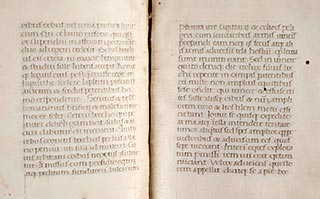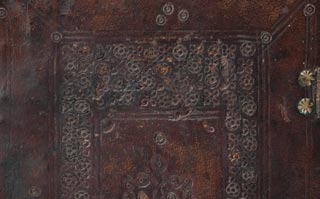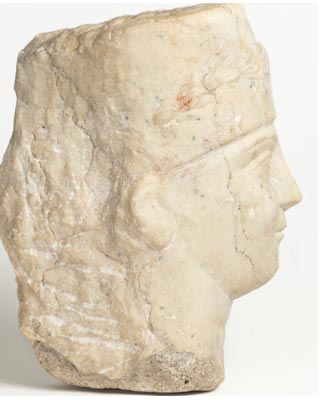The Canterbury Sallust is an account of the Roman Republic’s efforts to suppress the rebellious North African ruler Jugurtha. Towards the end of the second century BC, Jugurtha – an effective general and diplomat – usurped the kingdom of Numidia, now Algeria and part of Tunisia, from its pro-Roman ruler. The war ended with the rebellion suppressed and the defeated Jugurtha paraded through the streets of Rome.
A little over two and half centuries after Sallust put the finishing touches to his Jugurthine War, the Romans paraded another rebellious ruler through the streets of their capital. Zenobia was the queen of the Syrian city-state of Palmyra. Like Jugurtha, she survived the humiliation of the Roman triumph although, like Numidia, Palmyra itself came more directly under the control of the Roman state.

From Renaissance Vellum to Roman Sculpture


The Canterbury Sallust
Open at folios 100v-101r (top); Blind-stamped binding (bottom)
Northeast Italy, c. 1465-70. Sallust, Bellum Jugurthinum.
Codex, 110 folios bound in vellum
Christchurch, University of Canterbury, MS 2
The University of Canterbury’s beautiful manuscript of Sallust is indicative of the changes that occurred during the European Renaissance. While the text itself – a history of one of Rome’s North African wars – is over 2000 years old, the script it is written in seems strikingly familiar.
The Sallust represents attempts by scholars to escape the ‘Gothic’ style of the Middle Ages and rediscover ancient forms of writing. The results were popularised by the contemporary development of printing and continue to influence our fonts today. This copy of Sallust entered the University collection in 1966 thanks to the efforts of Professor Douglas Kidd and the generosity of Walter Colee. Colee was a Canterbury graduate and former headmaster of several Christchurch primary schools. He served as a member of both the Canterbury University College Council (1934-1949) and the University of New Zealand Senate.
This marble head of a priest comes from Palmyra and is believed to date from 200 to 273 AD, a period during which the city, a stopping point on the desert caravan route, was at its most prosperous.
The head is gracefully depicted slightly less than life size, wearing the modius, a cylindrical head dress indicating priestly status. Slight traces of red confirm the sculpture was originally brightly painted. This head was once attached to a reclining torso, situated either on the top of a sarcophagus or depicted in raised relief on a central wall of a family tomb. The Palmyrenes adopted the custom of funerary portraits from the Romans.
Want to know more?
Gary Morrison, 'The Canterbury Sallust', in Treasures of the University of Canterbury Library, ed. by Chris Jones & Bronwyn Matthews with Jennifer Clement (Christchurch: CUP, 2011)

Carved marble head, probably representing King Odaenathus and dating from 2nd Century A.D
Canterbury Museum, EA1980.282